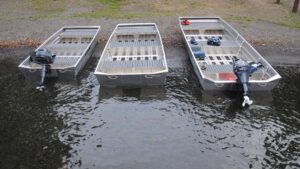There are numerous terms to get acquainted with if you are new to boating. The word “beam” may be one you’ve heard. What is a boat’s beam? The width of a boat at its widest point is known as the beam. Its full name is “beam overall,” or BOA, in nautical terminology.
People who are not familiar with seamanship may find many nautical terms to be like a foreign language. Please continue reading if you’re interested in learning more about the boat beam.
What Is A Boat Beam
The largest area of a boat is called the beam.
The structure of old wooden boats is where the word “beam” came from. Back then, boats were built with large wooden planks on either side, which strengthened the wooden boat. On the rib of the boat, from the keel to the gunwale, these wood pieces were positioned.
Smaller pieces of wood made up the boat’s deck. The ceiling of the first-floor cabin on ships with two floors was made up of the underside of the deck. On the first floor, you could see the wooden planks of the deck.
To gauge the size of the boat, measurements were made using the pieces of wood on the underside of the deck. Just by looking at the wooden planks under the deck, one could determine the size of a boat, i.e. the roof beams.
In modern times, the width of a boat is measured by its beam. Your boat’s ability to navigate underwater obstacles or pass through particular passageways can be determined by knowing how to measure or calculate the beam.

How To Measure The Beam Of A Boat
The size of a boat’s beam You must learn how to measure the boat’s beam because it will indicate whether or not you can pass a floating object without risk. Knowing what a boat beam is will be helpful to you in situations on the water.
You will need measuring tape, a carpenter’s square, ball twine, and some duct tape to measure the beam on a boat. There are two steps involved in measuring the beam: measuring the centerline first, then the beam.
Measure The Centerline
- Take a measurement of the stern’s width with the measuring tape. By halving the width, find the stern’s center. Then, make a mark on the deck at that midpoint.
- Tape the twine’s end to the center mark after grabbing one end of it.
- Tape the twine to the bow’s point after extending it toward the bow.
- Measure the width of the bow to obtain a more precise measurement. This measurement should be divided in half. Next, prick a mark in the bow’s middle. The twine should then be extended from the middle of the bow to the middle of the stern. You will be able to see the exact location of the deck or boat’s centerline.
Measure The Beam
- Select the boat’s widest area visually.
- Pull the measuring tape across the gunwales as soon as you have it. The top edge of the boat’s hull makes up this portion. The boat’s body is its hull. The tape must be parallel to the centerline and perpendicular to the surface. To make sure the measuring tape is positioned at a 90° angle to the centerline, use the carpenter’s square.
- The space between the hull’s exterior edges is known as the boat beam width.
- A second measurement should be taken to confirm that this is the boat’s widest point.
- Move the measuring tape once more a few inches behind and a few inches in front of the initial measurement you obtained from number 3.
- The true beam of the boat is determined by which of these two additional measurements is wider. The idea is that a boat’s beam should be its widest point.
The pilothouse or the cargo area are two places on the hull where you can measure the beam. However, you should indicate the names of the buildings from which you took the measurement.
Why Does A Boat’s Beam Matter
The beam of a ship plays a crucial role in stability as well as passage calculations.
Boat stability involves a lot of physics and math, so we won’t go into too much detail here. Only the broad issues concerning the beam and stability will be briefly discussed.
Wider Beam
A ship’s initial stability is typically higher the wider its beam. The initial stability of a vessel is its resistance to the center of gravity swaying in either direction. Due to an external force, such as wind or waves, as well as the movement of cargo inside the vessel, the center of gravity may shift sideways.
How the vessel’s volume is distributed away from its centerline has an impact on stability in addition to the beam. Lower vessel stability will result from most of the volume being near the centerline.
However, wide-beam boats may naturally be more stable than narrow-beam boats because wider beams enable the volume of a vessel to be distributed farther away from the center.
However, as the beam widens, the secondary stability frequently suffers. A vessel’s secondary stability is determined by how it behaves when it is turned on its side. Even though a boat with high initial stability may be challenging to tilt to one side, once tilted, it will capsize fairly quickly.
To be fair, a boat’s secondary stability is also influenced by the way its bottom is shaped. Although the primary stability decreases as the shape become more curved, secondary stability typically increases.
Primary stability is typically higher and secondary stability is typically lower for more square bottoms.
Narrower Beam
Weaker beams, which are essentially the opposite of wide beams, are available as an alternative. Though they are generally less stable and move more quickly (though this depends on other factors like boat length), narrow beam vessels are less stable.
Being less sluggish than wide-beam vessels is one of the main advantages of narrow-beam vessels. Additionally, narrow boats are easier to maneuver around obstacles and can fit into smaller waterways that are inaccessible to large boats.
Summary
A boat’s beam is its widest point. The beam is one of the most crucial things to take into account when purchasing or renting a boat. The beam will determine your vessel’s stability, volume, and speed.
In comparison to a boat with a narrow beam, a wider-beam boat is more stable. A boat’s width is measured from the left (port) to the right (starboard) side at its widest point in order to calculate its beam.



